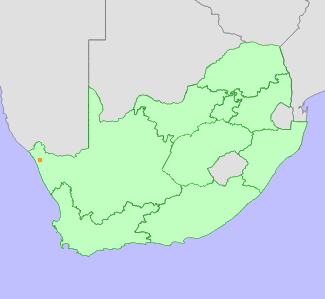|
Scientific Name | Conophytum stephanii Schwantes subsp. stephanii |
Higher Classification | Dicotyledons |
Family | AIZOACEAE |
Synonyms | Conophytum stephanii Schwantes subsp. abductum S.A.Hammer |
National Status |
Status and Criteria | Critically Endangered A4d |
Assessment Date | 2021/12/07 |
Assessor(s) | A.J. Young, P.G. Desmet, I. Ebrahim, D. Guo, L. Jabar, L. Knoetze, C. Rodgerson, P.C.V. Van Wyk & N.N. Mhlongo |
Justification | This dwarf succulent is endemic to the Northern Cape province of South Africa with an extent of occurrence (EOO) and area of occupancy (AOO) of 20 km2. The population is in decline due to illegal collection for the international trade in ornamental succulents and several thousand mature individuals have been removed from habitat since 2019. Illegal collection is likely to increase as there has been a dramatic increase in the number of species and volume of plants targeted since 2019 including many from the immediate area. The continued threat of illegal collection is therefore regarded as very high for this particular taxon as it is only recorded from a single location which is well known for its succulent richness. A decline of at least 80% of the population is very likely within the next generation (30 years). While climate change is also likely to impact this taxon the rapid declines to the population as a result of illegal collection means it qualifies as Critically Endangered under criterion A4. |
Distribution |
Endemism | South African endemic |
Provincial distribution | Northern Cape |
Range | This dwarf succulent is endemic to the Northern Cape Province of South Africa where it is only found in a single location with a very restricted geographic range. |
Habitat and Ecology |
Major system | Terrestrial |
Major habitats | Vyftienmyl se Berge Succulent Shrubland |
Description | This taxon is restricted to a small area in the Richtersveld bioregion of the Succulent Karoo biome. The plants occupy shaded cracks and crevices, often in deep ravines on steep cliff faces, on quartz-rich rocks.
This succulent has a generation length of 30 years. It is expected to be sensitive to the impacts of climate change as it does not disperse and while adapted to arid conditions, is dependent on limited seasonal rainfall. Species in the genus are sensitive to long periods of drought. Drought related mortality has been observed for other closely related taxa within the genus. |
Threats |
| Plants have been subject to illegal collection of mature individuals for the international trade in ornamental succulents with several thousand mature individuals removed from the single locality since 2019. This taxon has been highly sought after by collectors and is highly likely to remain so in future. The single location means that this taxon is highly susceptible to illegal collection resulting in a very rapid decline in the population of mature individuals. A population decline of 80-100% is suspected in a single generation (30 years).
There is no decline in habitat quality for this taxon as inferred by changes in vegetation cover determined from changes in Enhanced Vegetation Index (EVI) between 1984 and 2018 using Landsat data (Venter et al. 2020). Anthropogenic climate change is a long-term threat to this taxon. Climate models for the likely emission scenarios where emissions stay at present day levels (RCP 2.6) (Hausfather and Peters 2020) and worst case scenarios where emissions continue to increase during the 21st century (RCP 8.5) indicate that there will be a loss of suitable bioclimatic envelope of between 53% and 93% by 2080 for this succulent. However, as this taxon typically occurs in a sheltered habitat and possesses certain traits likely to afford resilience to xerophytic conditions it is expected to have a level of resilience to climate change and the expected population loss is reduced by 20% to 33%. Species in this genus have limited dispersal ability and migration to suitable habitats elsewhere is regarded as highly unlikely. |
Population |
This is only known from one location where it is sometimes locally abundant. The population size is estimated to be 20,000-30,000 mature individuals (South African National Parks survey 2021). The population is in decline due to illegal collection for the ornamental succulent plant trade. At least 3,000 plants have been removed from habitat between 2019 and the end of 2021 based on confiscation records, with many more having likely been removed but not intercepted by law enforcers. The population is also suspected to be declining due to an extended drought in the Richtersveld that started in 2016 and is still ongoing at the time of assessment.
|
Population trend | Decreasing |
Assessment History |
Taxon assessed |
Status and Criteria |
Citation/Red List version | | Conophytum stephanii Schwantes subsp. stephanii | VU D2 | 2015.1 | | Conophytum stephanii Schwantes subsp. stephanii | Least Concern | Raimondo et al. (2009) | |
Bibliography |
Hammer, S. 2002. Dumpling and his wife: New view of the genus Conophytum. EAE Creative Colour, Norwich.
Hammer, S.A. 1993. The genus Conophytum: A conograph. Succulent Plant Publications, Pretoria.
Hausfather, Z. and Peters, G.P. 2020. Emissions - the 'business as usual' story is misleading. Nature 577(618-620).
Opel, M.R. 2004. The rediscovery of Crassula alcicornis. Haseltonia 10:38-40.
Raimondo, D., von Staden, L., Foden, W., Victor, J.E., Helme, N.A., Turner, R.C., Kamundi, D.A. and Manyama, P.A. 2009. Red List of South African Plants. Strelitzia 25. South African National Biodiversity Institute, Pretoria.
|
Citation |
| Young, A.J., Desmet, P.G., Ebrahim, I., Guo, D., Jabar, L., Knoetze, L., Rodgerson, C., Van Wyk, P.C.V. & Mhlongo, N.N. 2021. Conophytum stephanii Schwantes subsp. stephanii. National Assessment: Red List of South African Plants version 2024.1. Accessed on 2025/11/07 |
 Comment on this assessment
Comment on this assessment


